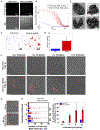Phosphatidylserine vesicles enable efficient en bloc transmission of enteroviruses
- PMID: 25679758
- PMCID: PMC6704014
- DOI: 10.1016/j.cell.2015.01.032
Phosphatidylserine vesicles enable efficient en bloc transmission of enteroviruses
Abstract
A central paradigm within virology is that each viral particle largely behaves as an independent infectious unit. Here, we demonstrate that clusters of enteroviral particles are packaged within phosphatidylserine (PS) lipid-enriched vesicles that are non-lytically released from cells and provide greater infection efficiency than free single viral particles. We show that vesicular PS lipids are co-factors to the relevant enterovirus receptors in mediating subsequent infectivity and transmission, in particular to primary human macrophages. We demonstrate that clustered packaging of viral particles within vesicles enables multiple viral RNA genomes to be collectively transferred into single cells. This study reveals a novel mode of viral transmission, where enteroviral genomes are transmitted from cell-to-cell en bloc in membrane-bound PS vesicles instead of as single independent genomes. This has implications for facilitating genetic cooperativity among viral quasispecies as well as enhancing viral replication.
Copyright © 2015 Elsevier Inc. All rights reserved.
Figures






References
-
- Borderia AV, Stapleford KA, and Vignuzzi M. (2011) RNA virus population diversityu:implications for interspecies transmission. Curr Opin Virol 1, 643–648 - PubMed
Publication types
MeSH terms
Substances
Grants and funding
LinkOut - more resources
Full Text Sources
Other Literature Sources
Research Materials

